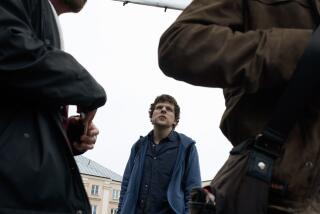Review: Peter Berg’s fierce ‘Lone Survivor’ captures realities of war
In “Lone Survivor,” filmmaker Peter Berg has finally found the right war to fight and the right cast to fight it. Based on Navy SEAL Marcus Luttrell’s memoir of a failed military operation in Afghanistan, the action is led by Mark Wahlberg, Taylor Kitsch, Emile Hirsch, Ben Foster and Eric Bana.
Whether it will be your kind of war depends. “Lone Survivor” is as much a paean to machismo as to the ultimate sacrifice of troops in the line of fire. That kind of unfiltered and excessive test of body, mind and spirit is characteristic of the muscular moviemaking Berg favors. Though it hasn’t always worked for the director (last year’s “Battleship” for example), it did on the football field in his 2004 breakthrough, “Friday Night Lights.” The attitude works better still in the Afghan mountains, where the combat is fierce and at ground level.
Berg, who wrote and directed, is more interested in how men deal with battle than the ideals or the politics that put them there. What the movie achieves, with a gruesome energy and a remarkable reality, is a firefight. Bullets ripping through bodies; harrowing falls snapping bones; blinding pain; men soldiering on despite wounds that should stop them. Captured in uncompromising detail by director of photography Tobias Schliessler, this movie is not for the faint of heart.
PHOTOS: Best films of 2013 | Betsy Sharkey
Luttrell and Patrick Robinson’s bestselling book zeros in on 2005’s Operation Red Wings. The plan was to put an elite special ops team close enough to a Taliban stronghold to take out a key rebel leader. Instead it devolved into one of the war’s costliest single missions, in human terms. Between the men on the ground and the team helicoptered in to try to extricate them, 19 troops were lost. One survived.
Though the title would suggest this is the survivor’s story, the film is very much about the collective and individual actions of five men. The team that heads into the remote Afghan mountains include sonar technician Matthew “Axe” Axelson (Foster), gunner’s mate Danny Dietz (Hirsch), medic Luttrell (Wahlberg) and leader Michael Murphy (Kitsch). Heading the operation back at base camp, and the rescue efforts that will follow, is Lt. Cmdr. Erik Kristensen (Bana).
Don’t judge the film by the first scenes. The visual montage of the extremes of SEALS training is unnecessary and heavy-handed.
PHOTOS: Best films of 2013 | Kenneth Turan
The movie actually begins a few minutes in with Luttrell knocking on death’s door. That scene accomplishes what the first fails to do — in a dramatic heartbeat of images and narration, it completely captures the spirit of “Lone Survivor’s” fighting force.
The story shifts back a few days and unfolds in two distinct parts — the mission, then the survival. The first stop is Bagram air base, Afghanistan. Inside the makeshift quarters where the special ops team awaits its next assignment, there is a locker room vibe where teasing looks a lot like hazing. A sense of lives back home is in the photos of girlfriends, wives and kids taped above beds, in email exchanges. But fundamentally this is a man’s world, a testosterone-saturated proving ground.
The switch flips to serious once the mission is underway. Shot on location in New Mexico, the sheer rock walls of the Santa Cristo range stand in for Afghanistan, putting the difficulty and the danger in sharp relief. The terrain is significant, providing some of the film’s most dramatic action.
PHOTOS: Box office top 10 of 2013
Though many already know the story, Berg is good at tension building as the team sets up in the hills above the village where the target, Ahmad Shah (Yousuf Azami), is thought to be hiding. An encounter with three goat herders sets disaster in motion. The Taliban is alerted and the SEALs are soon under attack. When all seems lost, the action shifts to a Pashtun village, a defiant local named Gulab (Ali Suliman) and his young son, who come to Luttrell’s aid. This is the film at its most hopeful.
But “Lone Survivor” is short on hope. The fight scenes are extensive and exist almost as a separate character, shaped by adrenaline, determination and fear. Even when a more workmanlike phase of the battle sets in, and one scenario after another is either discarded or attempted, the sense of duress never fades.
The production and costume designers have paid a great deal of attention to the details, from the uniforms and tribal robes, to the bullet wounds and blood. It certainly adds to the film’s verisimilitude. But what makes “Lone Survivor” work as well as it does are the human exchanges. Whether friend or foe, the moments feels all too real.
PHOTOS: Behind the scenes of movies and TV
Wahlberg is garnering much well-deserved attention for his gritty portrayal of Luttrell. That the other fighters become distinctive characters whose fate is just as critical to the film is a credit to Foster, Hirsch and Kitsch. As visceral as all four make the pain, it is the raw emotions that are so riveting. Pain in their eyes, tension rippling across faces, acceptance of the inevitable, but never retreat.
Berg has said he felt pressure to properly honor the lives of the real men of Red Wings, and the weight of that responsibility can be felt in every frame. When a sort of cinematic jingoism threatens, the nuances of the performances help pull things back. And the roll call of the fallen at the end feels exactly right.
---
‘Lone Survivor’
MPAA rating: R for strong bloody war violence and pervasive language.
Running time: 2 hours, 1 minute
Playing: At ArcLight Hollywood
More to Read
Only good movies
Get the Indie Focus newsletter, Mark Olsen's weekly guide to the world of cinema.
You may occasionally receive promotional content from the Los Angeles Times.











